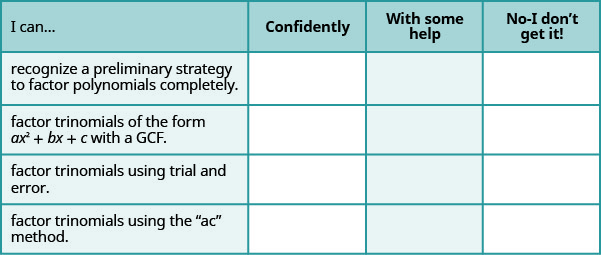7.3E: Exercises
( \newcommand{\kernel}{\mathrm{null}\,}\)
Practice Makes Perfect
Recognize a Preliminary Strategy to Factor Polynomials Completely
In the following exercises, identify the best method to use to factor each polynomial.
- 10q2+50
- a2−5a−14
- uv+2u+3v+6
- Answer
-
- factor the GCF, binomial
- Undo FOIL
- factor by grouping
- n2+10n+24
- 8u2+16
- pq+5p+2q+10
- x2+4x−21
- ab+10b+4a+40
- 6c2+24
- Answer
-
- undo FOIL
- factor by grouping
- factor the GCF, binomial
- 20x2+100
- uv+6u+4v+24
- y2−8y+15
In the following exercises, factor completely.
5x2+35x+30
- Answer
-
5(x+1)(x+6)
12s2+24s+12
2z2−2z−24
- Answer
-
2(z−4)(z+3)
3u2−12u−36
7v2−63v+56
- Answer
-
7(v−1)(v−8)
5w2−30w+45
p3−8p2−20p
- Answer
-
p(p−10)(p+2)
q3−5q2−24q
3m3−21m2+30m
- Answer
-
3m(m−5)(m−2)
11n3−55n2+44n
5x4+10x3−75x2
- Answer
-
5x2(x−3)(x+5)
6y4+12y3−48y2
Factor Trinomials Using Trial and Error
In the following exercises, factor.
2t2+7t+5
- Answer
-
(2t+5)(t+1)
5y2+16y+11
11x2+34x+3
- Answer
-
(11x+1)(x+3)
7b2+50b+7
4w2−5w+1
- Answer
-
(4w−1)(w−1)
5x2−17x+6
6p2−19p+10
- Answer
-
(3p−2)(2p−5)
21m2−29m+10
4q2−7q−2
- Answer
-
(4q+1)(q−2)
10y2−53y−11
4p2+17p−15
- Answer
-
(4p−3)(p+5)
6u2+5u−14
16x2−32x+16
- Answer
-
16(x−1)(x−1)
81a2+153a−18
30q3+140q2+80q
- Answer
-
10q(3q+2)(q+4)
5y3+30y2−35y
In the following exercises, factor.
5n2+21n+4
- Answer
-
(5n+1)(n+4)
8w2+25w+3
9z2+15z+4
- Answer
-
(3z+1)(3z+4)
3m2+26m+48
4k2−16k+15
- Answer
-
(2k−3)(2k−5)
4q2−9q+5
5s2−9s+4
- Answer
-
(5s−4)(s−1)
4r2−20r+25
6y2+y−15
- Answer
-
(3y+5)(2y−3)
6p2+p−22
2n2−27n−45
- Answer
-
(2n+3)(n−15)
12z2−41z−11
3x2+5x+4
- Answer
-
prime
4y2+15y+6
60y2+290y−50
- Answer
-
10(6y−1)(y+5)
6u2−46u−16
48z3−102z2−45z
- Answer
-
3z(8z+3)(2z−5)
90n3+42n2−216n
16s2+40s+24
- Answer
-
8(2s+3)(s+1)
24p2+160p+96
48y2+12y−36
- Answer
-
12(4y−3)(y+1)
30x2+105x−60
In the following exercises, factor.
12y2−29y+14
- Answer
-
(4y−7)(3y−2)
12x2+36y−24z
a2−a−20
- Answer
-
(a−5)(a+4)
m2−m−12
6n2+5n−4
- Answer
-
(2n−1)(3n+4)
12y^2−37y+21
2p^2+4p+3
- Answer
-
prime
3q^2+6q+2
13z^2+39z−26
- Answer
-
13(z^2+3z−2)
5r^2+25r+30
x^2+3x−28
- Answer
-
(x+7)(x−4)
6u^2+7u−5
3p^2+21p
- Answer
-
3p(p+7)
7x^2−21x
6r^2+30r+36
- Answer
-
6(r+2)(r+3)
18m^2+15m+3
24n^2+20n+4
- Answer
-
4(2n+1)(3n+1)
4a^2+5a+2
x^2+2x−24
- Answer
-
(x+6)(x−4)
2b^2−7b+4
Everyday Math
Height of a toy rocket The height of a toy rocket launched with an initial speed of 80 feet per second from the balcony of an apartment building is related to the number of seconds, t, since it is launched by the trinomial −16t^2+80t+96. Factor this trinomial.
- Answer
-
−16(t−6)(t+1)
Height of a beach ball The height of a beach ball tossed up with an initial speed of 12 feet per second from a height of 4 feet is related to the number of seconds, t, since it is tossed by the trinomial −16t^2+12t+4. Factor this trinomial.
Writing Exercises
List, in order, all the steps you take when using the “ac” method to factor a trinomial of the form ax^2+bx+c.
- Answer
-
Answers may vary.
How is the “ac” method similar to the “undo FOIL” method? How is it different?
What are the questions, in order, that you ask yourself as you start to factor a polynomial? What do you need to do as a result of the answer to each question?
- Answer
-
Answers may vary.
On your paper draw the chart that summarizes the factoring strategy. Try to do it without looking at the book. When you are done, look back at the book to finish it or verify it.
a. After completing the exercises, use this checklist to evaluate your mastery of the objectives of this section.

b. What does this checklist tell you about your mastery of this section? What steps will you take to improve?


